
| Opus 41 - Baroque Flute |
|
|
The eighteenth century marked an important period in the development of the flute. The instrument was made in four sections, or joints, and keys were added. These joints were built in different lengths so that performers could tune the flute to the standard pitches of particular cities or to those used in chamber, church or opera music. In this century of transition between the baroque and classical periods, the flute gained widespread popularity. Virtuoso performers gave public concerts, a novelty that subsequently became common practice. Peter Noy 
Peter Noy has been making flutes for over ten years. In his Toronto workshop, opened in 1988, he specializes in making recorders and early flutes, and repairs modern woodwind instruments. A flautist and devotee of early music, Noy was prompted by curiosity to explore flute making and teach himself the craft. He undertook research by studying the construction of various early instruments and acquired solid experience in repairing wind instruments by working for Gary Armstrong Woodwinds. A number of grants from the Canada Council and the Ontario Arts Council enabled him to study historic instruments in a dozen European collections. Peter Noy has participated in numerous exhibitions and international shows in North America and Europe. |
 |


